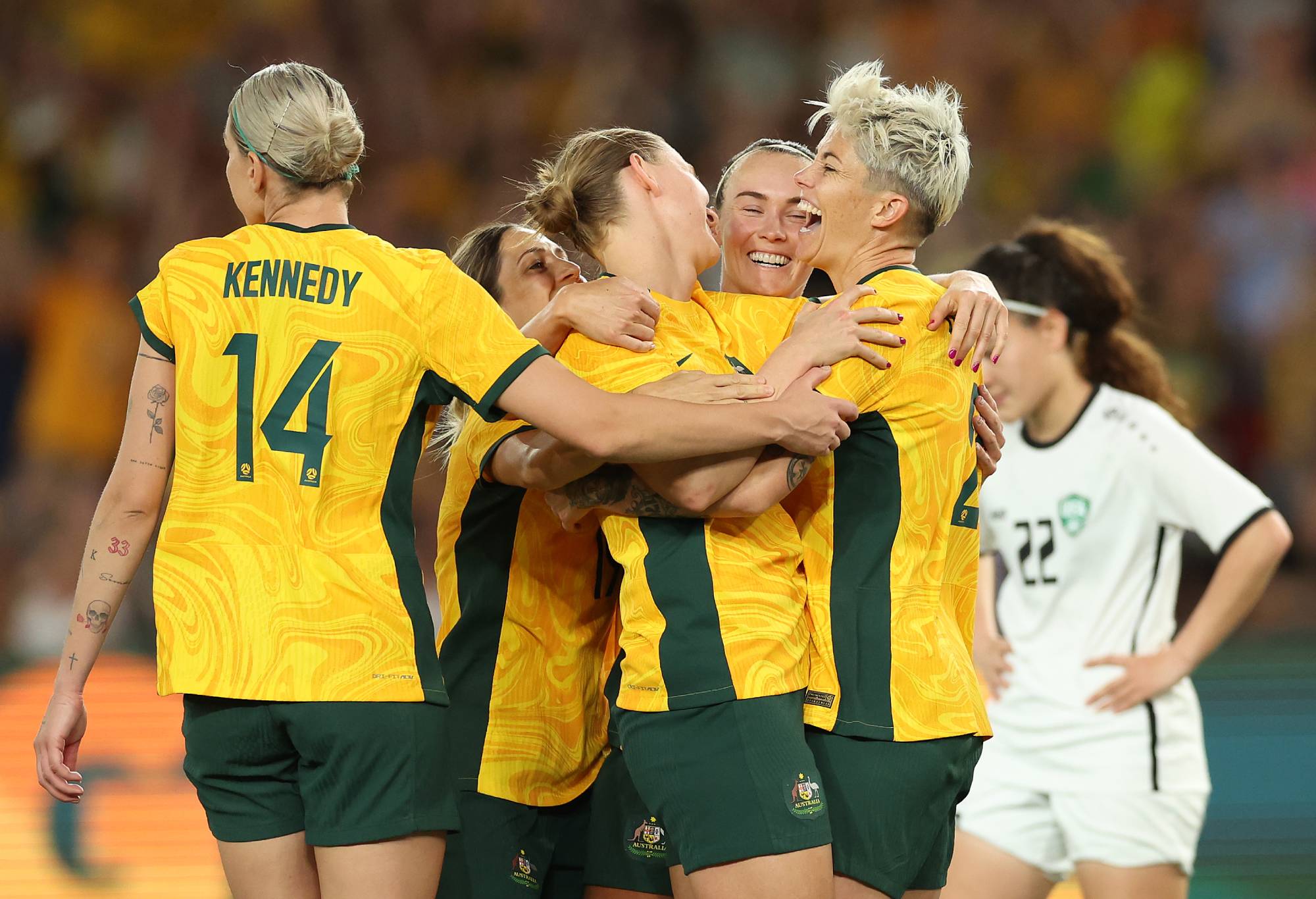Have the Matildas eclipsed the Socceroos? Whatever you think, Australian football fans are in for some exciting times

In a practically dead rubber on a searing hot Melbourne Wednesday evening at Marvel Stadium against an Uzbekistan team ranked 47th in the world, the Matildas put Uzbekistan to the sword roared on by a capacity crowd of 54,120 people.
This was the Matildas 12th sold out home game in a row. While the majority of these were huge crowds that somewhat unexpectedly turned out during last year’s Women’s World Cup against top teams like Ireland, Nigeria, Canada, Denmark, France, England, and Sweden, and a pre-tournament friendly against France, there have also been sold out matches against lower-ranked Asian teams such as Iran, the Philippines (59,156 in a match that was moved to Perth’s larger Optus Stadium to accommodate demand), Chinese Taipei, and now last week against Uzbekistan.
The Matildas celebrate a goal against Uzbekistan. (Photo by Robert Cianflone/Getty Images)
In recent years the Matildas have been growing crowds, support and interest for a number of reasons:
The majority of the team’s players play in the big leagues for storied teams such as Arsenal, Manchester City, Tottenham Hotspur, Liverpool, Everton, West Ham, Paris St Germain, Olympique Lyon and Real Madrid, and the Matildas have a genuine superstar in Chelsea’s Sam Kerr, who unfortunately injured her ACL in January and will miss the Paris Olympics.
Players regularly playing in the top leagues is the big difference between the Matildas and the current Socceroos.
They are ranked just outside the top 10 (currently 12th) in the FIFA rankings and were as high as 4th a few years ago, meaning they are able to compete with and beat the best teams in the world. Aussies like winners, and the Matildas fourth place at the World Cup last year was easily Australia’s best ever finish. Although they fell short of lifting the trophy, they took the scalps of some big teams along the way.
A feel-good vibe enhanced by personable and media-friendly female players (and their articulate Swedish coach Tony Gustavsson). This has helped with their media coverage and appeal to mainstream Australia. A casual analysis of a typical Matildas crowd clearly shows a lot more kids, young girls, women and a more family-friendly crowd and atmosphere compared to Socceroos crowds that tend to be predominantly male.
It’s no secret a number of the Matildas are lesbians and they provide a shining example of inclusiveness, acceptance, openness, and support for LGBTIQA+ people. The recent Netflix documentary “The World at our Feet” showed the Matildas stars’ lives, both on the pitch and off the pitch with their partners.
The Socceroos performed under expectations at the recent AFC Asian Cup. (Photo by Robert Cianflone/Getty Images)
They are also role models for female equality and closing the gender pay gap. In 2019, the Matildas became one of the only national teams in world football to sign an equal pay agreement when they negotiated their first ever joint collective bargaining agreement with the Socceroos. This was an enormous step forward from the days where players were not even paid enough to cover travel costs and were forced to resort to a nude calendar to raise money.
In 2019 when equal pay was announced some in the public questioned why the female national team should be paid the same as the male national team with the disparity in crowds, popularity, sponsorship, and results. That may have been true in 2019 but in 2024 the Matildas are exceeding the Socceroos in all of these metrics.
Take for example:
The Socceroos play Lebanon at Commbank Stadium on the 21st of March, which may well be sold out, but the stadium’s capacity is only 30,000 compared to the 54,120 the Matildas had at Marvel. The Matildas had 3 crowds of over 75,000 at the World Cup and there could have been more crowds of this size had bigger venues been available.
The Matildas main sponsor is the Commonwealth bank versus Subway for the Socceroos.
The Socceroos made the round of 16 at the 2022 World Cup, equalling the Golden Generation’s best ever 2006 effort. The Matildas finished fourth at last year‘s World Cup.
Ellie Carpenter celebrates a World Cup goal. (Photo by James Worsfold/Getty Images)
The Matildas have just qualified for the Paris Olympics later this year, whereas the men’s national team (U23 for the Olympics) must finish in the top 3 teams at next month’s U-23 Asia Cup to qualify. Assuming they are able to progress from their group, they must then beat probably South Korea or Japan in the quarter finals, and then win their semi-final or the 3rd place playoff which will be very tough.
There’s never been a more exciting time to be a football fan in Australia, with the Matildas incredible rise to become Australia’s most beloved sports team, best ever results for our national teams in both the men’s and women’s World Cups, the emergence of young stars in Europe, a National Second Tier football league starting next year, and last but not least the high quality football and unpredictable results of our much-maligned A-League, with recent positive news of a new owner for Perth Glory and expansion team Auckland joining in the 2024/25 season, and even more positive news perhaps coming soon.
